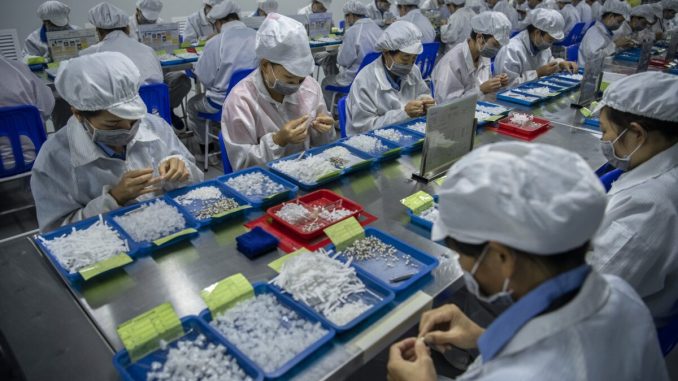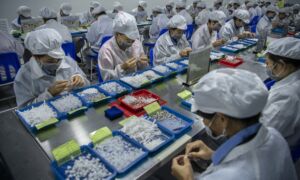

China’s labor market is undergoing structural changes, with a shrinking labor force and rising labor costs. Young people are reluctant to enter factories, and the international labor market is shifting to Southeast Asia and other places. Some analysts expressed concerns that China’s status as the “world’s factory” may end within a year.
According to the seventh national census released by Chinese authorities, China’s prime workforce population is decreasing. People aged 15 to 59, accounting for 63 percent of the total population, decreased by 7 percentage points from a decade ago. While another 18 percent of the total population, people aged 60 or above, increased by 5 percentage points from a decade ago.
Ren Zeping, chief economist at Soochow Securities, said that the census results indicate China’s population is aging at an unprecedented speed and scale, with the country’s baby boomers—born between 1962 and 1976—stepping out of the labor market at an accelerated pace. China’s economy greatly enjoyed the additional demographic in the past. However, that same age group (60 and above) will retire in the near future.
China had 286 million migrant workers in 2020, 5 million less than the previous year, according to the Report on Monitoring and Investigation of Migrant Workers released by the regime’s Bureau of Statistics in 2020. Among them, migrant workers in manufacturing jobs accounted for 27 percent.
Statistical data showed that from 2008 to 2018, the number of migrant workers in China’s manufacturing jobs declined at an average annual rate of 2.8 percent.
Ren said in the next five years, China will not only face problems of an aging population, fewer children in each household, and young people not getting married, but will also have negative population growth. This is one of the biggest dangers affecting China’s economic and social development.
The sharp decline in the labor force directly challenges China’s status as the world’s factory.
Rising Cost of Labor
The decrease in the labor force leads directly to a change in market supply and demand. Wage increases for blue-collar employees are also inevitable. In addition, the Chinese Communist Party has been printing more banknotes in recent years, resulting in serious inflation. The cost of living, such as clothing, food, housing, and transportation has become higher and higher, so labor costs have naturally increased as well.
According to data released by China’s Bureau of Statistics on April 30, migrant workers in manufacturing jobs earned an average of $637 a month in 2020, an increase of $21.50, or 3.5 percent, over the previous year, making it the fastest-growing sector. In 2006, the average monthly income for migrant workers in manufacturing or doing business in cities was $150. With the monthly salary roughly quadrupling in 15 years, labor costs of manufacturing enterprises have also increased.
Wang Jinqiu, a Shanghai-based company executive, told The Epoch Times that high labor costs are a big expense for Chinese entrepreneurs. Employers are also required to provide workers with essential insurance and pensions—accounting for about a third of their wages. For example, for a worker who earns $777 a month, the employer must pay about $200 for various fees in addition to the worker’s own contribution to the social security system, making the cost of employment for business owners very expensive.
Young People Reluctant to Enter Factories
Another reality affecting China’s labor market is that young people today are reluctant to work in factories.
Most young people today are the only child in their families. Many are highly educated and have little desire to work as blue-collar workers. Even those in rural areas are not willing to leave their hometown and parents to work in places with long working hours, minimal security, and a poor environment.
Chinese media Caijing also reported that manufacturing is losing its appeal to young people. More young people prefer to work in their hometowns in emerging service industries such as food delivery, taxi driving, express delivery, and live broadcasting, which offer both flexibility and fast income.
In 2020, 170 million migrant workers left their homes, 5 million fewer than the previous year, Caijing said in its report. Zhejiang, Jiangsu, Guangdong, and other big manufacturing provinces, which once had a large influx of foreign workers, are now facing “recruitment difficulty” and “labor shortage.”
Dong Sheng is the owner of Guangzhou Renyi Labor Dispatch Co. He told Caijing that in 2006, companies could “find however many they wanted” through his labor dispatch service, but starting in 2019, finding workers has become harder every year. Last year, more than 200 people were hired a day, but by the end of April this year, that number had dropped to about 70.
In order to recruit skilled workers, employers in Guangzhou were willing to line up on the streets and hold up signs, waiting for workers to pick them. This was considered to be an unusually humble gesture by these business owners, Chinese media reported.
International Labor Market Shifting to Southeast Asia and Other Places
In the past few years, foreign companies have been leaving China in droves and moving factories to Southeast Asian countries. Panasonic, for example, will close its dry battery plant in Shanghai and transfer some of the work to its Central American plants for the North American market. Sony moved its smartphone factory from Beijing to Thailand. Apple is moving eight foundry factories from China to India. Samsung has shut down factories in China that make phones, computers, and televisions and moved them to Vietnam. Earlier, Nike, Adidas, Uniqlo, Muji, and other international brands had moved their factories to Cambodia, Vietnam, Indonesia, Bangladesh, and other places.
According to Caijing, a chairman of a Zhejiang enterprise went to Uzbekistan in 2019 to investigate the country’s investment environment for the manufacturing industry. He found that he can enjoy preferential policies on land, factories, taxes, and other aspects if he invests in Uzbekistan. The monthly salary of each local employee is about $155, and “they are also very capable and can work overtime every day.”
In economics, when a country’s surplus labor force disappears causing wages to rise steeply, it is called a “Lewis turning point.” Many foreign companies have spotted the “Lewis turning point” in China and are rapidly relocating their manufacturing facilities.
Japan’s Daiwa Securities has predicted that China will lose its status as the world’s factory by 2022 at the latest.
Zhang Jinglun, a U.S.-based researcher on finance, business, and economics, told The Epoch Times that a worsening economic environment and mass exodus of manufacturing plants will lead to an army of unemployed workers—squeezing labor costs—but a shrinking labor force and an aging society will also weigh on the economy, creating a vicious cycle.






Be the first to comment